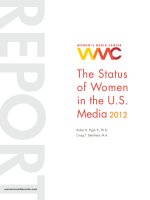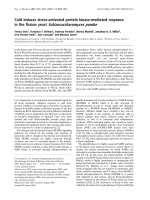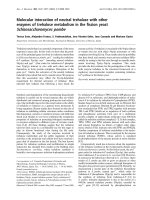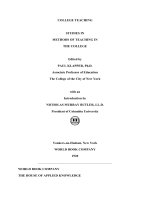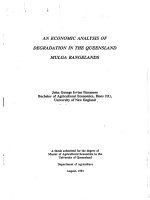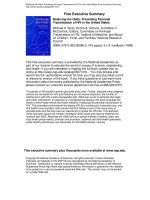Regulation of cytokinesis in the fission yeast schizosaccharomyces pombe
Bạn đang xem bản rút gọn của tài liệu. Xem và tải ngay bản đầy đủ của tài liệu tại đây (9.34 MB, 198 trang )
REGULATION OF CYTOKINESIS IN THE FISSION YEAST
SCHIZOSACCHAROMYCES POMBE
MITHILESH MISHRA
(M. Sc., Jawaharlal Nehru University)
A THESIS SUBMITTED
FOR THE DEGREE OF DOCTOR OF PHILOSOPHY
TEMASEK LIFE SCIENCES LABORATORY
NATIONAL UNIVERSITY OF SINGAPORE
2007
ii
DEDICATED TO MY PARENTS: MEERA MISHRA AND DR. R. P. MISHRA;
DR(s). S. BULCHAND AND Maj. H.O. BULCHAND
iii
ACKNOWLEDGEMENTS
This work would not have been possible without the contribution of many people.
I would especially like to thank my supervisor Prof. Mohan Balasubramanian for
giving me the opportunity to work in his lab. I will always cherish his gentle
mentorship, his infectious enthusiasm for science and unflagging support through
the years.
Many people collaborated with me during the course of this work. I am grateful
to Dr. Jim Karagiannis for collaboration on the project described in chapter 4 and
especially for the results presented in Figure 9. I would like to thank Maya
Sevugan and Pritpal Singh for their help with the GST-pull down assay, Chang
Kai Chen and Ventris M. D’souza for the characterization of the swo1-w1 mutant
and Huang Yinyi for help with the yeast two-hybrid assay. Many thanks are due
to Drs. Dan McCollum and Susan Trautmann for their helpful discussions and
sharing of unpublished observations.
During the course of this work various people generously made antibodies and
yeast strains available to me. I wish to thank Drs. Juan Jimenez, Keith Gull, Paul
Russell, Paul Nurse, Koei Okazaki, Matthew O’Connell, Tony Carr, Kathy Gould,
Dan McCollum and all the contributors of the Cell Division Laboratory strain and
plasmid collection for reagents.
iv
I would like to thank my thesis committee members Drs. Naweed Naqvi, Uttam
Surana and William Chia for their comments and suggestions.
I would like to thank all the members past and present of the yeast and fungal
laboratories at the Temasek Life Sciences Laboratory and at the Institute of
Molecular Agrobiology, specially Suniti Naqvi, Srividya Rajagopalan, Snezhka
Oliferanko, Volker Wachtler, Naweed Naqvi, Jim Karagiannis, Andrea Bimbo,
Chew Ting Gang, Ge Wanzhong, Huang Yinyi, Loo Tsui Han, Hong Yan, Maya
Sevugan, Liu Jianhua, Anup Padmanabhan and Ramanujam Srinivasan for helpful
discussions and help with experiments in addition to creating a wonderful
environment to work in.
I am thankful to IMA/TLL facilities and staff for general support.
Thanks are due to Volker Wachtler, Ramanujam Srinivasan and Sarada Bulchand
for critical reading of my thesis.
I am grateful to the National Science and Technology board; Agency for Science,
Technology and Research; Temasek Life Sciences Laboratory and the Singapore
Millennium Foundation for financial support.
This work would not have been possible without the support of my family and
friends.
v
TABLE OF CONTENTS:
1 Introduction 1
1.1 The cell division cycle and cytokinesis 1
1.2 Cytokinesis: early insights 3
1.2.1 The contractile ring 7
1.3 Cytokinesis in animal cells 10
1.4 Cytokinesis in plant cells 11
1.5 Cytokinesis in budding yeast 12
1.6 Cytokinesis in fission yeast 13
1.6.1 The fission yeast Schizosaccharomyces pombe 13
1.6.2 The cell cycle and its regulation 14
1.6.3 Division site selection 15
1.6.4 Actomyosin-ring assembly 16
1.6.5 Ring contraction, membrane addition and division septum
deposition 20
1.6.6 Coordination of cytokinesis with the nuclear cycle 21
1.6.7 The septation initiation network (SIN) 22
1.6.8 The Cdc14 family phosphatase Clp1p 25
1.6.9 The cytokinesis checkpoint 28
2 Materials and Methods 32
2.1 Yeast 32
2.1.1 Yeast strains 32
2.1.3 Drugs used 36
2.1.4 Yeast genetics and molecular methods 36
2.2 Escherichia coli 37
2.2.1 Growth and maintenance of bacteria 38
2.2.2 Transformation of E. coli 38
2.3 Cell biology and microscopy 38
2.3.1 Reagents 38
2.3.2 Nuclei, F-actin and septum staining 39
2.3.3 Immunofluoresence microscopy 39
2.3.4 Time lapse microscopy 41
2.4 Protein and immunological methods 42
2.4.1 Extraction of protein from S. pombe 42
2.4.2 Immunoprecipitation 43
2.4.3 Protein electrophoresis, immunoblotting and detection 43
2.5 Two-hybrid system 44
2.5 Association of Clp1p-HA and GST-Rad24P 45
3 Swo1p facilitates the actomyosin ring formation and myosin II assembly and
function 46
vi
3.1 Introduction 46
3.2 Results 47
3.2.1 Characterization of the cytokinetic phenotype in swo1-w1 cells 47
3.2.2 The swo1-w1 mutation leads to defects in actomyosin ring
assembly 50
3.2.3 The swo1-w1 mutant shows a genetic interaction with myo2-E1
and rng3-65 alleles 52
3.2.4 myo2-E1 and rng3-65 strains show a heightened sensitivity to the
Hsp90 inhibitor geldanamycin 55
3.2.5 Swo1p-GFP persists at the actomyosin ring only in the myo2-E1
strain 57
3.2.6 Swo1p physically interacts with the Myo2p-head domain and with
Rng3p 60
3.2.7 Myo2-E1p levels are reduced in absence of Swo1p and Rng3p 63
3.3 Discussion 65
4 Clp1p ensures completion of cytokinesis in response to minor perturbation of
the cell division machinery in S. pombe 71
4.1 Introduction 71
4.2 Results 73
4.2.1 Clp1p is essential when the cytokinetic apparatus is mildly
perturbed 73
4.2.3 Clp1p-dependent maintenance of the actomyosin ring upon
perturbation of cytokinesis 82
4.2.4 Active SIN signaling greatly bypasses the need for Clp1p function
upon perturbation of the cell division machinery 88
4.2.5 Clp1p localizes to the cytoplasm and is important for the
maintenance of active SIN cascade when cytokinesis is perturbed 91
4.2.6 Cells lacking the 14-3-3 protein Rad24p are sensitive to
perturbation of cell division structures 94
4.2.7 Rad24p is required for cytoplasmic retention of Clp1p and for
prolonged SIN signaling 98
4.2.8 Rad24p physically associates with phosphorylated Clp1p in vitro
101
4.2.9 Ectopic activation of the SIN compensates for the loss of Rad24p
during cytokinesis 104
4.2.10 Rad24p localizes to the actomyosin ring and the spindle pole
bodies in cells undergoing mitosis and cytokinesis in a SIN-dependent
manner. 107
4.3 Discussion 110
References: 122
vii
Summary
Cytokinesis is the terminal phase of the cell cycle through which the cellular
constituents of mother cells are partitioned into two daughter cells resulting in an
increase in cell number. The spatio-temporal regulation of cytokinesis is
important for successful division, the failure of which may result in cells with
altered ploidy and loss of viability. In recent years, the fission yeast
Schizosaccharomyces pombe has emerged as an attractive model organism for the
study of cytokinesis. S. pombe is a rod-shaped unicellular fungus that grows by
elongation at the tips. Like the metazoan S. pombe cells divide by medial fission
through an actomyosin based contractile ring producing two daughter cells of
equal size. The actomyosin ring consists of about 50 different proteins including
actin, actin regulatory proteins, type II myosin heavy and light chains. The
mechanism by which various components of the actomyosin ring associate with
each other to form a functional complex remains to be determined.
The ordered execution of cell cycle events requires surveillance mechanisms, or
cell cycle checkpoints, which ensure that the initiation of later events is coupled to
the completion of earlier cell cycle events (Hartwell and Winert, 1989).
Checkpoints that monitor completion of DNA synthesis, DNA damage and
mitotic spindle assembly have been extensively characterized in various
eukaryotes. However, the existence of a similar monitoring mechanism for the
completion of cytokinesis has remained an open question. Fission yeast mutants
defective in actomyosin ring formation and function exhibit a delay in entry into
viii
the subsequent nuclear division cycle following cytokinetic failure. This G2
delay depends on the Septation Initiation Network (SIN), a signaling network
essential for cytokinesis, and on the non-essential Cdc14p family phosphatase
Clp1p / Flp1p and has been proposed to signify a “cytokinesis checkpoint”.
However the physiological significance of such a checkpoint and the molecular
role of Clp1p in the process remain to be determined.
In the first half of this study I demonstrate that fission yeast heat-shock protein 90
(Swo1p) is essential for actomyosin ring assembly. I provide evidence that
Swo1p together with the UCS domain protein Rng3p modulates the stability and
function of type II myosin Myo2p of fission yeast. Temperature sensitive alleles
of swo1, show strong genetic interaction with a specific mutant allele of the
fission yeast type II myosin head myo2-E1, but not with two other alleles of myo2
or with mutations affecting 14 other genes important for cytokinesis. myo2-E1
and rng3-65 mutants show heightened sensitivity to the Hsp90 inhibitor
geldanamycin. I further show that Swo1p and Rng3p physically associate with
the head domain of Myo2p, and Myo2-E1p levels are reduced in the absence of
Swo1p and Rng3p. My analysis establishes that Swo1p and Rng3p collaborate in
vivo to modulate myosin II stability and function.
In the second half of this study I demonstrate the physiological significance of the
cytokinesis checkpoint in fission yeast. I show that delays in cytokinesis caused
by minor perturbations to different components of the cytokinetic machinery,
ix
which normally causes only mild defects, become lethal in the absence of Clp1p.
The cell division apparatus is repaired and reinforced in response to activation of
the cytokinesis checkpoint. Ectopic activation of SIN significantly bypasses the
requirement of Clp1p for the G2 delay as well as completion of cytokinesis. I
further show that Clp1p, normally nucleolar in interphase is maintained in the
cytoplasm until completion of cytokinesis and the cytoplasmic retention of Clp1p
is essential for checkpoint activation. This cytoplasmic retention of Clp1p is
dependent on the SIN and the 14-3-3 protein Rad24p. Rad24p binds to the
phosphorylated form of Clp1p. This physical interaction depends on the function
of the SIN component Sid2p. I conclude that the Clp1p-dependent cytokinesis
checkpoint provides a previously unrecognized cell survival advantage when the
cell division apparatus is mildly perturbed.
x
LIST OF TABLES AND FIGURES:
Table 1: Schizosaccharomyces pombe strains used in this study……………… 25
Figure 1: Characterization of the swo1-w1 mutant strain 49
Figure 2: Swo1p function is essential for assembly of a normal actomyosin ring.
51
Figure 3: The swo1-w1 mutant shows a synthetic lethal interaction with both
myo2-E1 and rng3-65 mutant strains 54
Figure 4: The mutant strains myo2-E1, rng3-65 and swo1-w1 show a heightened
sensitivity to geldanamycin. 56
Figure 5: Swo1p-GFP is detected at the division site in myo2-E1 cells but not in
myo2-S1 or myo2-S2 cells 59
Figure 6: Physical interactions between Myo2p and Rng3p with Swo1p. 62
Figure 7: Swo1p and Rng3p are required for the stability of Myo2-E1p 64
Figure 8: Clp1p is essential when cell division structures are mildly perturbed and
ensures the completion of cytokinesis. 77
Figure 9: Nuclear cycle arrest is insufficient to allow completion of cytokinesis
upon perturbation of the cell division machinery. 81
Figure 10: Clp1p is important for the maintenance of the actomyosin ring at the
medial region of the cell 84
Figure 11: Dynamics of Clp1p dependent actomyosin ring maintenance upon
perturbation of the cytokinetic machinery. 87
Figure 12: SIN mutants are hypersensitive to mild perturbations of the cell
division machinery whereas ectopic activation of the SIN compensates for
the loss of Clp1p. 90
Figure 13: Clp1p localizes to the cytoplasm and is important for the maintenance
of an active SIN cascade upon checkpoint activation 93
Figure 14: rad24 Δ cells are sensitive to perturbation of cell division structures. 97
xi
Figure 15: Rad24p is required for cytoplasmic retention of Clp1p and for
prolonged SIN signaling upon perturbation of the cytokinetic machinery. 100
Figure 16: Rad24p binds to phosphorylated Clp1p in vitro 103
Figure 17: Ectopic activation of the SIN compensates for the loss of Rad24p
during cytokinesis. 106
Figure 18: Rad24p localizes to the actomyosin ring and the spindle pole body in
cells undergoing mitosis in a SIN-dependent manner. 109
xii
LIST OF ABBREVIATIONS:
BSA bovine serum albumin
DAPI 4’6, -diamidino-2-phenylindolle
DMSO dimethyl sulphoxide
DTT dithiothereitol
EDTA Ethylenediamine tetraacetic acid
GAP GTPase activating protein
GEF guanine nucleotide exchange factor
GFP green fluorescent protein
GST glutathione-S-transferase
LatA latrunculin A
MAPK mitogen associated protein kinase
MEN mitotic exit network
PBS phosphate buffer saline
PEG polyethylene glycol
PMSF phenylmethylsulphonylfluoride
RNAi RNA interference
SDS sodium dodecyl sulphate
SDS-PAGE sodium dodecyl sulphate-polyacrylamide gel
electrophoresis
SIN septation initiation network
SPB spindle pole body
TE Tris EDTA
xiii
TEMED N,N,N’N’-tettramethylenediamine
ts temperature sensitive
xiv
PUBLICATIONS
First author publications:
• Mishra, M., M. D'Souza V, K. C. Chang, Y. Huang and M. K.
Balasubramanian (2005). "Hsp90 protein in fission yeast Swo1p and
UCS protein Rng3p facilitate myosin II assembly and function." Eukaryot
Cell 4, 567-76.
• Mishra, M., J. Karagiannis, S. Trautmann, H. Wang, D. McCollum
and M. K. Balasubramanian (2004). "The Clp1p/Flp1p phosphatase
ensures completion of cytokinesis in response to minor perturbation of the
cell division machinery in Schizosaccharomyces pombe." J Cell Sci 117,
3897-910.
• Mishra, M., J. Karagiannis, M. Sevugan, P. Singh and M. K.
Balasubramanian (2005). "The 14-3-3 protein rad24p modulates function
of the cdc14p family phosphatase clp1p/flp1p in fission yeast." Curr Biol
15, 1376-83.
Co-author publications:
• Motegi, F., M. Mishra, M. K. Balasubramanian and I. Mabuchi
(2004). "Myosin-II reorganization during mitosis is controlled temporally
by its dephosphorylation and spatially by Mid1 in fission yeast." J Cell
Biol 165, 685-95.
• Rajagopalan, S., M. Mishra and M. K. Balasubramanian (2006).
"Schizosaccharomyces pombe homolog of Survivin, Bir1p, exhibits a
novel dynamic behavior at the spindle mid-zone." Genes Cells 11, 815-27.
• Srinivasan, R., M. Mishra, M. Murata-Hori and M. K.
Balasubramanian (2007). "Filament formation of the Escherichia coli
actin-related protein, MreB, in fission yeast." Curr Biol 17, 266-72.
Invited book chapter:
• J. Karagiannis, Mishra, M., and M. K. Balasubramanian (2005). “A
cell cycle checkpoint ensures the completion of cytokinesis upon
perturbation of the cell division machinery in Schizosaccharomyces
pombe. Signal Transduction of Cell Division, 217-235
1
1 Introduction
1.1 The cell division cycle and cytokinesis.
Growth and reproduction is fundamental to life. Cells, which constitute the basic
building block of all living organisms, undergo a series of events, termed as cell
cycle to achieve this end. The cell cycle consists of four distinct phases: G1 (Gap)
phase, S (Synthesis) phase, G2 (Gap) phase, collectively known as interphase
which results in net growth of cells and faithful duplication of its genetic material
and M (Mitosis) phase. M phase is itself composed of two tightly coupled
processes: mitosis, in which the cell's chromosomes are equally portioned
between the two daughter cells, and cytokinesis, in which the mother cell
physically divides to give rise to two independent daughters.
Cytokinesis is the final event of the cell cycle that physically separates the mother
cell into two independent daughter cells. While the absence of cytokinesis is
sometimes necessary under certain specialized circumstances, for example in the
slime mould Physarium or during the early development of Drosophila embryos,
cytokinesis is essential for proliferation and differentiation of an actively growing
cell population. In the absence of cytokinesis, control over ploidy is lost, as well
as potential for growth of cellular population. In order to generate two identical
daughter cells from mitosis, the fidelity of cytokinesis must be precisely
controlled in establishing the spatial orientation of the cleavage plane and in the
2
actual timing of the cleavage onset (Glotzer 2001; Guertin et al. 2002;
Balasubramanian et al. 2004).
Though cytokinesis is the most readily visualized cell cycle events and was first
documented more then a hundred years ago (Rappaport 1996), the molecular
mechanisms underlying this process are only beginning to emerge. Most of the
early insights into cytokinesis came from clever micromanipulation experiments
carried out by embryologists studying echinoderm and Xenopus embryos
(Rappaport 1996). These studies led to great insights into the cellular structures
that orchestrate cell division, but the underlying molecular machinery was largely
unknown. In recent years details are emerging on the molecular pathways that
regulate various stages of cytokinesis and how they are coordinated with and by
other events of the cell cycle. This has been facilitated by studies on model
organisms with facile genetics and improved light microscopic methods as well as
advances in functional genomics and proteomics methods including systematic
RNA interference (RNAi) screens (Guertin et al. 2002; Balasubramanian et al.
2004; Eggert et al. 2006). It has become apparent that cytokinesis like mitosis
occurs in distinct stages, which include site selection, assembly of contractile
components, activation of contraction, new membrane insertion and septation (in
yeast cells) and cell separation (Guertin et al. 2002; Balasubramanian et al. 2004;
Eggert et al. 2006).
Though the purpose of cytokinesis is universal, there are variations in its
execution in different organisms and cell types. Each organism or cell type seems
to have evolved its regulatory circuit according to its particular needs. In a
number of eukaryotic cells, including yeast, nematodes, insects and mammals,
3
cytokinesis is achieved through the use of an actomyosin-based contractile ring
(Hales et al. 1999). However, studies done with Dictyostelium cells deficient in
expression of either the heavy or the light chain of myosin II were capable of
dividing on a solid substrate (De Lozanne and Spudich 1987; Pollenz et al. 1992;
Chen et al. 1994). Similarly in certain genetic backgrounds, type II myosin is also
dispensable for cytokinesis in the budding yeast, Saccharomyces cereviciae (Bi et
al. 1998). In plant cells, on the other hand, cytokinesis does not appear to involve
the function of an actomyosin ring, but is achieved through the assembly of a new
cell wall at the division site (Jurgens 2005). In yeast and other fungal cells, cell
wall materials are concomitantly deposited between the two daughter cells as the
actomyosin ring constricts. The primary septum is ultimately digested by septum
cleaving enzymes physically liberating the two daughter cells (Guertin et al.
2002). Given this diversity observed in different organisms it is important to
study cytokinesis using various experimental systems to gain a relatively
complete understanding of the mechanisms regulating this cellular event.
1.2 Cytokinesis: early insights
Division of living cells could be observed with relative ease long before the
process could be satisfactorily analyzed by experimentation. Most of the early
insights into cytokinesis came from clever micromanipulation experiments carried
out by embryologists studying the division of fertilized eggs of marine
invertebrates (Rappaport 1996). The eggs could be collected in large numbers,
maintained in seawater or simple saline medium and be induced to undergo
synchronous divisions upon fertilization. Furthermore they are durable, large
4
enough to experimentally manipulate and transparent thereby making cell division
events like condensation of chromosomes, formation of mitotic spindles and
asters and the formation of cleavage furrows observable in real time under the
light microscope (Rappaport 1986). These early reports lead to many descriptive
accounts of mitosis and cytokinesis and much speculation concerning the physical
process underlying the visible events. It was postulated that the mitotic apparatus
would be involved in the events of cytokinesis to the same extent that it was
involved in the physical events of mitosis (Wilson 1928). This early theory was
disproved when it was shown that cell division proceeded even after the removal
of various parts of the mitotic apparatus or nucleus of a sand dollar egg by means
of micromanipulation or disruption of the same by aspiration after the division
plane was specified (Hiramoto 1956; Hiramoto 1971). Similar results were
obtained when the spindle structure was disassembled by using the drug
clolchicine (Beams 1940). These results implied that the physical mechanism
responsible for furrow formation was located at the cell surface. The observed
co-relation between the position and orientation of the mitotic apparatus and the
furrow was then explained by the hypothesis that the mitotic apparatus altered the
region of the overlying cortex by some form of stimulatory activity (Rappaport
1967). This assumption was supported by a frequently made observation that, in
eggs flattened to such an extent that the mitotic apparatus was abnormally
oriented, the furrows were also abnormally oriented with respect to the egg axis,
but normal with respect to the mitotic apparatus(Rappaport 1961; Rappaport and
Ebstein 1965; Rappaport 1971). The formation of the furrow was attributed to the
re-organization of subsurface cytoplasm in the equatorial plane that eventually
resulted in the formation of a cleavage furrow. It lead to the assumption that
cytokinesis is a multi step process. During the first step the mitotic apparatus
alters the overlying cortical surface and then becomes dispensable. In the second
5
step the altered surface organizes the division mechanism and in the last step the
division mechanism actively constricts the cell (Rappaport 1971).
Micromanipulation of fertilized eggs of marine invertebrates was instructive in
addressing issues concerning the source of the signal as well as the time and
duration of the interaction required between the cortex and the mitotic apparatus.
The time when the furrow is fixed in the overlying cortex was determined by
inactivating or removing the mitotic apparatus at different times before furrowing
was anticipated. Experiments with echinoderm eggs in which the mitotic
apparatus was dissociated by colchicine, revealed that at some point during late
anaphase the presence of a normal mitotic apparatus was no longer required for
furrowing (Beams 1940). Hiramoto (Hiramoto 1956) found that echinoderm eggs
from which spindles were removed by microsurgery after anaphase, subsequently
divided. The fact that the cortex of the entire embryo was competent to form the
cleavage furrow was also demonstrated by experiments where the mitotic
apparatus was moved around in the cells. Harvey (Harvey 1935) centrifuged sea
urchin
zygotes to displace the mitotic apparatus and the subsequent
division plane.
Rappaport (Rappaport 1985) moved the mitotic apparatus
repeatedly in cylindrical
sand dollar eggs and observed that
a single mitotic apparatus could induce the
formation of multiple
(up to 13) cleavage furrows; each time, a furrow formed at
the
new position of the mitotic apparatus, while the old furrow
regressed.
However two opposing hypotheses were eventually postulated for the formation
of the cleavage furrow. The poles or the equator can behave differently if one of
the two is changed. Which of the two regions was actively altered became a point
of speculation. The equatorial stimulation hypothesis proposes that an instructive
6
signal is delivered by the interdigitating asters (or the spindles depending on the
cell type) and the cleavage furrow is formed by a direct response in the stimulated
equatorial region (Marsland and Landau 1954; Rappaport 1961; Rappaport 1967).
The polar stimulation (relaxation) model on the other hand proposes that, asters or
the telophase nuclei deliver signals that stimulate the activity of the poles (Swann
and Mitchison 1958; Wolpert 1960; White and Borisy 1983). This stimulus leads
to the relaxation of the polar cortex or dampens down cortical contraction
everywhere except the furrow. Though apparently opposing, the two models are
not mutually exclusive and the possiblity that both contribute to furrow formation
remains.
Most of these early observations from micromanipulation experiments were found
to be consistent with the equatorial stimulation hypothesis. In a classic
perforation experiment, a hole was made perpendicular to the long axis of the
mitotic apparatus before it's formation (Dan 1943). Punctures made on any part
of the surface outside the equatorial region had no effect on division but when the
cell was perforated in the equatorial plane such that a block was imposed in the
equatorial region between the spindle and overlying cortex, furrowing of the
cortex near this region did not occur. Similar results were obtained when the
stimulus was blocked in the equatorial plane by introduction of oil droplets or
glass needles (Rappaport and Rappaport 1983). Another set of ingenious
experiments carried out in sand dollar eggs demonstrated that the cleavage furrow
formed midway between the asters even when the two centromeres were not
connected to each other by the spindles there by proving yet again that the
overlapping microtubule asters and not the chromosomes or any other part of the
spindle signals to the cell cortex to indicate the position of cleavage furrow
formation (Rappaport 1961). The center of an undivided sand dollar egg was
7
pushed by the tip of a glass needle to make a doughnut-shaped cell. The mitotic
apparatus formed eccentrically in this cell and the doughnut was cut in the center
by the first cleavage, as expected. The second division though was very
revealing. Two furrows formed normally, being determined by the two centers of
the mitotic apparatus. In addition, an extra furrow was formed at the intersection
of the two asters from the two different mitotic apparatus.
1.2.1 The contractile ring
The nature of the contractile mechanism was another area, which received much
attention during these instructive early studies. Marshland and Landau (Marsland
and Landau 1954) when studying the effects of temperature and pressure on the
cleavage of eggs of various animals proposed that the force generated at the
cleavage furrow resulted from contraction of a superficial gel in the equator.
They went on to propose that there was a turnover of contractile material in the
furrow that involved a continuous series of sol-gel reactions. That the cleavage
furrow actually exerted force was confirmed by microinjection of oil in dividing
sea urchin eggs (Hiramoto 1965). The droplet was constricted by the ingressing
furrow, indicating that a force larger than the surface tension of the oil droplet in
the cytoplasm was generated in the furrow. The extent of the force was measured
directly in a cleaving sand dollar egg (Rappaport 1967). Two micro-needles one
rigid and the other flexible and calibrated, were inserted in a dividing sand dollar
egg and the force in the range of 1.5-9 X 10
–3
dyn/cm
2
was measured by
determining the degree of bend imparted by the furrow in the flexible micro-
needle.
8
Electron microscopic studies around the same time revealed that the contractile
ring really exists as a bundle of microfilaments surrounding the cell at the equator.
Schroeder (Schroeder 1968), reported the presence of microfilaments in the
cleavage furrow of a jellyfish egg oriented parallel to the cleavage plane. Since
the first discovery, contractile ring filaments have been identified in eggs of a
variety of animals as well as in cultured cells (Mabuchi 1986). The depth (0.1-0.2
µm) and width (5-10 µm) of a contractile ring was found to be fairly constant
amongst various types of cells. Schroeder (Schroeder 1972) carefully observed
the formation and disappearance of the contractile ring in the first cleavage furrow
of the sea urchin egg. He found that the contractile ring reduced its volume as
cleavage proceeded; it’s diameter decreased leaving the thickness and width
unchanged. This led him to propose that these filaments are dynamic in nature
and they depolymerize or fragment into smaller polymers or move away from the
ring as the ring constricts. The microfilaments in the contractile ring were
identified as actin filaments by their decoration with heavy mero-myosin in newt
eggs, crane fly spermatocytes, sea urchin eggs and HeLa cells (Perry et al. 1971;
Forer and Behnke 1972; Schroeder 1973). Functional significance for actin in
cleavage furrow formation was further supported by evidence that cytochalasin B
treatment of HeLa cells or Xenopus eggs reversibly blocked cytokinesis with
concomitant disappearance or disorganization of the contractile ring filaments
(Bluemink 1970; Schroeder 1970; Schroeder 1972). Further physiological
evidence that actin plays a role in cytokinesis came from studies using phalloidin,
a bicyclic peptide from a toadstool which was shown to bind selectively to actin
filament and stabilize it against depolymerization in vitro (Lengsfeld et al. 1974;
Dancker et al. 1975). Microinjection of phalloidin led to cleavage arrest
(Hamaguchi and Mabuchi 1982).
9
Studies by Mabuchi in echinoderm eggs (Mabuchi 1973; Mabuchi 1974) added
another important component to the contractile ring. Isolated cortical layers of
dividing sea urchin and star-fish eggs were shown to contain myosin (Mabuchi
1973; Mabuchi 1974). Immunoflurosence studies in HeLa cells using antibodies
against human myosin showed that myosin was concentrated at the cleavage
furrow (Fujiwara and Pollard 1976). Furthermore microinjection of anti-myosin
antibodies into starfish egg lead to inhibition of cleavage. It was thereby proposed
that actin and myosin interact to produce the force for furrow constriction
(Mabuchi and Okuno 1977)
These studies led to great insights into the cellular structures that orchestrate cell
division, but the underlying molecular machinery was largely unknown. In recent
years details have been emerging on the molecular pathways that regulate various
stages of cytokinesis and how they are coordinated with and by other events of the
cell cycle. This has been facilitated by studies on model organisms with facile
genetics and improved light microscopic methods as well as advances in
functional genomics and proteomics methods including systematic RNA
interference (RNAi) screens (Guertin et al. 2002; Balasubramanian et al. 2004;
Eggert et al. 2006). It has become apparent that cytokinesis like mitosis occurs in
distinct stages, which include site selection, assembly of contractile-ring
components, activation of contraction, new membrane insertion and septation (in
yeast cells) and cell separation (Guertin et al. 2002; Balasubramanian et al. 2004;
Eggert et al. 2006).
10
1.3 Cytokinesis in animal cells
Animal cells divide by invagination of the cell membrane, forming a cleavage
furrow that gradually constricts generating a membrane barrier between the
cytoplasmic constituents of each daughter cell (Glotzer 2001). The specification
of the cell-division site by the mitotic apparatus provides a way to spatially and
temporally coordinate cell-division events with chromosomal segregation
(Glotzer 2004). The furrow is formed upon the onset of anaphase at the
equatorial site between the centrosomes and consists of filamentous actin (F-
actin), non-muscle type II myosin and other proteins that organize into a
contractile ring called the actomyosin ring. Studies using microtubule de-
polymerizing drugs established the dependency of cleavage furrow formation on
microtubules (Beams 1940). In different cell types either the astral microtubules
or the central spindle or both are thought to be important for cleavage furrow
specification though the nature of signals that are transduced to the cortex remains
unresolved (Burgess and Chang 2005). Astral microtubules and the central
spindle might actively promote furrow ingression at the equatorial region.
Alternatively, polar microtubules may inhibit furrow formation and the central
spindle may establish a zone of cortex that is free from such inhibition (Glotzer
2004).
Cleavage-furrow formation requires the small GTPase RhoA. Either localization
of RhoA or its localized activation by its GEFs (guanine-nucleotide-exchange
factors) may lie downstream of any such signals generated by mitotic
microtubules linking it to furrow formation (Kishi et al. 1993; Mabuchi et al.
1993; Drechsel et al. 1997; Prokopenko et al. 1999; Tatsumoto et al. 1999;
Yonemura et al. 2004). EM studies in marine invertebrate embryos provided the
11
first evidence of the existence of an equatorial actomyosin ring (Schroeder 1968),
which was later found to be conserved in other organisms. Recent studies in
various systems have revealed that the contractile actomyosin ring is highly
dynamic and constantly remodeled (Pelham and Chang 2002; Wong et al. 2002;
Guha et al. 2005). The actomyosin ring is thought to generate the force that
deforms the plasma membrane and leads to cleavage furrow ingression. The
ingressing furrow constricts components of the spindle midzone into a focused
structure called the midbody. The furrow is sealed during abscission, when the
plasma membrane resolves generating two independent daughter cells (Glotzer
2001).
1.4 Cytokinesis in plant cells
In contrast to animal cells, plant cells do not seem to use the actomyosin ring to
divide and consistent with this the genome of Arabidopsis lacks genes that encode
myosin II (2000). Unlike animal cells, which centripetally constrict the cleavage
furrow from the plasma membrane inwards, plant cells divide by construction of
cell plates sandwiched between new plasma membrane on either side (reviewed
by Jurgens 2006). The plane of division is determined in prophase and early in
mitosis by the formation of a plant-specific cytoskeletal array, the preprophase
band composed of cortical microtubules and actin filaments (Wick 1991). The
preprophase band, which marks the future cortical division site, appears at the cell
cortex in late G2 phase and disappears with the breakdown of the nuclear
envelope during prometaphase. The preprophase band is thought to guide the
formation of the phragmoplast, which originates late in anaphase via a process
that remains poorly understood (Lloyd and Hussey 2001). The phragmoplast is
composed of oppositely oriented microtubules where golgi-derived vesicles are
